11.5: Manga and Anime (1950-1999)
- Page ID
- 224463
\( \newcommand{\vecs}[1]{\overset { \scriptstyle \rightharpoonup} {\mathbf{#1}} } \)
\( \newcommand{\vecd}[1]{\overset{-\!-\!\rightharpoonup}{\vphantom{a}\smash {#1}}} \)
\( \newcommand{\id}{\mathrm{id}}\) \( \newcommand{\Span}{\mathrm{span}}\)
( \newcommand{\kernel}{\mathrm{null}\,}\) \( \newcommand{\range}{\mathrm{range}\,}\)
\( \newcommand{\RealPart}{\mathrm{Re}}\) \( \newcommand{\ImaginaryPart}{\mathrm{Im}}\)
\( \newcommand{\Argument}{\mathrm{Arg}}\) \( \newcommand{\norm}[1]{\| #1 \|}\)
\( \newcommand{\inner}[2]{\langle #1, #2 \rangle}\)
\( \newcommand{\Span}{\mathrm{span}}\)
\( \newcommand{\id}{\mathrm{id}}\)
\( \newcommand{\Span}{\mathrm{span}}\)
\( \newcommand{\kernel}{\mathrm{null}\,}\)
\( \newcommand{\range}{\mathrm{range}\,}\)
\( \newcommand{\RealPart}{\mathrm{Re}}\)
\( \newcommand{\ImaginaryPart}{\mathrm{Im}}\)
\( \newcommand{\Argument}{\mathrm{Arg}}\)
\( \newcommand{\norm}[1]{\| #1 \|}\)
\( \newcommand{\inner}[2]{\langle #1, #2 \rangle}\)
\( \newcommand{\Span}{\mathrm{span}}\) \( \newcommand{\AA}{\unicode[.8,0]{x212B}}\)
\( \newcommand{\vectorA}[1]{\vec{#1}} % arrow\)
\( \newcommand{\vectorAt}[1]{\vec{\text{#1}}} % arrow\)
\( \newcommand{\vectorB}[1]{\overset { \scriptstyle \rightharpoonup} {\mathbf{#1}} } \)
\( \newcommand{\vectorC}[1]{\textbf{#1}} \)
\( \newcommand{\vectorD}[1]{\overrightarrow{#1}} \)
\( \newcommand{\vectorDt}[1]{\overrightarrow{\text{#1}}} \)
\( \newcommand{\vectE}[1]{\overset{-\!-\!\rightharpoonup}{\vphantom{a}\smash{\mathbf {#1}}}} \)
\( \newcommand{\vecs}[1]{\overset { \scriptstyle \rightharpoonup} {\mathbf{#1}} } \)
\( \newcommand{\vecd}[1]{\overset{-\!-\!\rightharpoonup}{\vphantom{a}\smash {#1}}} \)
\(\newcommand{\avec}{\mathbf a}\) \(\newcommand{\bvec}{\mathbf b}\) \(\newcommand{\cvec}{\mathbf c}\) \(\newcommand{\dvec}{\mathbf d}\) \(\newcommand{\dtil}{\widetilde{\mathbf d}}\) \(\newcommand{\evec}{\mathbf e}\) \(\newcommand{\fvec}{\mathbf f}\) \(\newcommand{\nvec}{\mathbf n}\) \(\newcommand{\pvec}{\mathbf p}\) \(\newcommand{\qvec}{\mathbf q}\) \(\newcommand{\svec}{\mathbf s}\) \(\newcommand{\tvec}{\mathbf t}\) \(\newcommand{\uvec}{\mathbf u}\) \(\newcommand{\vvec}{\mathbf v}\) \(\newcommand{\wvec}{\mathbf w}\) \(\newcommand{\xvec}{\mathbf x}\) \(\newcommand{\yvec}{\mathbf y}\) \(\newcommand{\zvec}{\mathbf z}\) \(\newcommand{\rvec}{\mathbf r}\) \(\newcommand{\mvec}{\mathbf m}\) \(\newcommand{\zerovec}{\mathbf 0}\) \(\newcommand{\onevec}{\mathbf 1}\) \(\newcommand{\real}{\mathbb R}\) \(\newcommand{\twovec}[2]{\left[\begin{array}{r}#1 \\ #2 \end{array}\right]}\) \(\newcommand{\ctwovec}[2]{\left[\begin{array}{c}#1 \\ #2 \end{array}\right]}\) \(\newcommand{\threevec}[3]{\left[\begin{array}{r}#1 \\ #2 \\ #3 \end{array}\right]}\) \(\newcommand{\cthreevec}[3]{\left[\begin{array}{c}#1 \\ #2 \\ #3 \end{array}\right]}\) \(\newcommand{\fourvec}[4]{\left[\begin{array}{r}#1 \\ #2 \\ #3 \\ #4 \end{array}\right]}\) \(\newcommand{\cfourvec}[4]{\left[\begin{array}{c}#1 \\ #2 \\ #3 \\ #4 \end{array}\right]}\) \(\newcommand{\fivevec}[5]{\left[\begin{array}{r}#1 \\ #2 \\ #3 \\ #4 \\ #5 \\ \end{array}\right]}\) \(\newcommand{\cfivevec}[5]{\left[\begin{array}{c}#1 \\ #2 \\ #3 \\ #4 \\ #5 \\ \end{array}\right]}\) \(\newcommand{\mattwo}[4]{\left[\begin{array}{rr}#1 \amp #2 \\ #3 \amp #4 \\ \end{array}\right]}\) \(\newcommand{\laspan}[1]{\text{Span}\{#1\}}\) \(\newcommand{\bcal}{\cal B}\) \(\newcommand{\ccal}{\cal C}\) \(\newcommand{\scal}{\cal S}\) \(\newcommand{\wcal}{\cal W}\) \(\newcommand{\ecal}{\cal E}\) \(\newcommand{\coords}[2]{\left\{#1\right\}_{#2}}\) \(\newcommand{\gray}[1]{\color{gray}{#1}}\) \(\newcommand{\lgray}[1]{\color{lightgray}{#1}}\) \(\newcommand{\rank}{\operatorname{rank}}\) \(\newcommand{\row}{\text{Row}}\) \(\newcommand{\col}{\text{Col}}\) \(\renewcommand{\row}{\text{Row}}\) \(\newcommand{\nul}{\text{Nul}}\) \(\newcommand{\var}{\text{Var}}\) \(\newcommand{\corr}{\text{corr}}\) \(\newcommand{\len}[1]{\left|#1\right|}\) \(\newcommand{\bbar}{\overline{\bvec}}\) \(\newcommand{\bhat}{\widehat{\bvec}}\) \(\newcommand{\bperp}{\bvec^\perp}\) \(\newcommand{\xhat}{\widehat{\xvec}}\) \(\newcommand{\vhat}{\widehat{\vvec}}\) \(\newcommand{\uhat}{\widehat{\uvec}}\) \(\newcommand{\what}{\widehat{\wvec}}\) \(\newcommand{\Sighat}{\widehat{\Sigma}}\) \(\newcommand{\lt}{<}\) \(\newcommand{\gt}{>}\) \(\newcommand{\amp}{&}\) \(\definecolor{fillinmathshade}{gray}{0.9}\)Introduction
Manga is a graphic art appearing in comics or graphic novels. The concept originated in Japan and is based on early Japanese styles. Manga may appear as comics or cartoons and printed in magazines and books. Published manga stories are generally drawn in black and white, although some artists do incorporate colors. Anime is closely associated with manga. Anime was based on either hand-drawn or computer-generated styles of animation. Many manga books and comics were transformed into anime images and animated in games or videos. Manga incorporates multiple subject matters, including action, sports, crime, fantasy, history, horror, sex, science fiction, and war, as well as other topics.[1] People of all ages read or view manga; however, some work may not be proper for children, while others are geared toward children.
"Comics accounted for 27 percent of all books and magazines published in Japan in 1980; the more than one billion manga in circulation yearly amount to roughly 10 for every man, woman, and child in Japan." [2] The plot is laid out in single episodes of a serial story and printed. Popular and well-liked stories are frequently made into animated films.
Manga grew immensely popular in Japan after 1950 with two different types; shōnen manga was based on subject matter for boys, and shōjo manga was created for girls. Initially, most manga comics were made by men and based on shōnen manga subjects. At the beginning of the 1970s, a group of female artists called the Year 24 began creating shōjo manga to expand the themes and add complexity and social constructs to the artwork. Early shōjo stories for girls covered simple romantic or sentimental stories. When shōnen stories for boys found new innovative directions like fantasy or science fiction, girls' stories stagnated.
The Year 24 group began to create female characters in their stories. Their themes covered politics, sexuality, female heroics, and philosophical ideas. The artists of Year 24 also started developing specific aesthetics associated with the shōjo stories. Their figures were elongated, their eyes sparkled, and their hair flowed. They also used very delicate linework against abstracted backgrounds and decorative embellishments. The artists used flowery icons to emulate different emotions; for example, "trees are full of life, and flowers are in bloom to represent beauty, while they change to lifeless with petals flowing in the wind to express grief and sorrow." [3] Later, artists expanded on the themes and brought shōjo stories about female heroes closer to the exploits of male heroes. The video is based on a discussion of shōjo manga and its development. Artists in this section include:
- Hayao Miyazaki (1941-)
- Katsuhiro Otomo (1954-)
- Akira Toriyama (1955-2024)
- Rumiko Takahashi (1957-)
- Hiromu Arakawa (1973-)
- Eiichiro Oda (1975-)
- Keiko Takemiya (1950-)
- Satoshi Tajiri (1965-)
- Naoko Takeuchi (1967-)
- Hideko Mizuno (1939-)
In today's video, we will compare manga and animation, the two big storytelling worlds. Stick till the end and tell us which one you prefer!
Hayao Miyazaki
Hayao Miyazaki (1941-) was born in Tokyo City, part of the Empire of Japan. He was born right before the attack on Pearl Harbor, Hawaii, when the United States entered World War II. Miyazaki's father was the director of an airplane company, a vital industry in the war effort, and the family lived an affluent life. Although his mother had spinal tuberculosis, she had a long life and was a significant influence on Miyazaki's artistic career. As a child, Miyazaki's memories were mainly of bombed-out cities resulting from the war. He has always wanted to be a manga artist and has tried to emulate some popular manga artists. He did not believe his work was very good and destroyed much of it. Although Miyazaki continued to work on manga ideas and drew thousands of pages of stories, he received his degree in political science and economics. Miyazaki continued his manga work and was hired by a company to produce animation and start a successful career. Miyazaki is frequently considered the godfather of animation in Japan, and some extend the idea to the world. His characters and movies are cultural icons. Miyazaki's movie Spirited Away remains Japan's top-grossing movie.
Miyazaki is one of the most prolific, well-known, and cherished anime directors. His work was seen by children who followed the endearing characters even when they became adults. Miyazaki often positioned the characters in stories about environmentalism, growing up stories, and views against wars. He used cute and unforgettable characters portrayed with hand-drawn animation set in detailed landscapes. A composite of his characters (11.5.1) shows the different popular characters. Animation scholar Helen McCarthy said, "Firstly they are very beautiful and emotionally very honest, audiences everywhere can relate to that. Secondly, they are many-layered so that children can enjoy them, but people at later stages of life can also find meaning in them."[1]

He’s the founder of the biggest animation studio in Japan. He’s a pacifist, a feminist, and a strong advocate for the environment. He’s a two-time Oscar winner. This is Hayao Miyazaki.Video text/introduction.
My Neighbor Totoro (11.5.2) is a fantasy film by Miyazaki and focuses on two sisters living in rural Japan. The film covers the sisters' interactions with friendly wood spirits and incorporates animism, the environment, and Shinto symbology concepts. The young girls have a large, furry creature named Totoro, their friend. The film received multiple awards, including the Animage Anime Grand Prix, and it is one of the top animation films. The film became exceptionally popular for home videos and a wide variety of merchandise.

Figure \(\PageIndex{2}\): Mon voisin Totoro (My Neighbour Totoro) (1988, film) (Festival international du film d'animation-Annecy, CC BY-NC-ND 2.0)
While Mei and Satsuki wait for their father at the bus stop with Totoro, a Cat Bus approaches. After Totoro boards the strange bus with their father’s umbrella, the two are shocked but are even more excited to let their father know that their friend returned. About Max: Max is the culture-defining entertainment service for every mood. With a variety of genres that include your favorite series and movies from iconic brands and treasured franchises, it delivers irresistible stories every time. From reuniting with life-long favorites to uncovering new ones you haven’t discovered yet, there's something for every moment, every feeling, every you.
Katsuhiro Otomo
Katsuhiro Otomo (1954-) was born in rural Japan, and with little to do in the countryside, he read manga and started drawing his manga. In high school, he met the editor of a company printing manga and told Otomo to contact him if Otomo moved to Tokyo. After high school, Otomo moved to Tokyo, contacted the person, and started working there. He began creating his manga series, and his first significant work was Dōmu. When Otomo started, most manga were geikiga (for adults) or sports-based. As a child, he was interested in science fiction and wanted to incorporate something more interesting. He also wanted to make his work more illustrative, balancing fantasy and realism. Otomo was the first artist to depict his characters with Japanese-style faces. Otomo wrote multiple stories and became one of the most influential artists for other manga and anime artists.
One of Otomo's first successful stories was Akira (11.5.3), a science fiction-based story set in Tokyo after an early explosion destroyed the city. Set around the adventures of a teenage biker gang (11.5.4), the cyberpunk-style books weave through stories of politics, social loneliness, corruption, and dominance. The stories were adventurous, exploited mature concepts, had creative artwork, and were a commercial success. The manga stories were made into an animated film and significantly influenced the anime industry. Otomo himself transitioned from manga to mostly anime.
.jpg?revision=1)

30 years ago Akira debuted to a world that wasn't ready for it. Three decades later and it's still as important - and as fun - as it ever was. In this video I take a look at the creation of Akira, the legacy it left behind, and the madman responsible for it all: Katsuhiro Otomo.
Akira Toriyama
Akira Toriyama (1955-2024) was born in Kiyosu, Japan. He and his classmates in school spent their free time drawing manga and anime. As Toriyama demonstrated advanced skills, he spent more time watching others, and when he completed high school, he went to work for an advertising agency instead of attending a university. He entered different magazine competitions and finally was successful with Dr. Slump. Because Toriyama liked kung fu films, his publisher suggested he create a story based on martial arts. Dragon Boy became popular and became the best-selling manga series ever.
Dr. Slump (11.5.5) became a well-known manga series about a small girl robot who lived in the bizarre Penguin Village. It became an anime television series, multiple novels, video games, and animated films. The series started Toriyama's career. The little girl in the series needed glasses and was very naïve. The stories are humorous and make fun of Japanese and American culture. One of the characters is Suppaman, who is overweight, short, and a buffoon. He can't fly, so he tries to use a skateboard and acts like he is flying.

The world-renowned manga artist, Toriyama Akira, died on March 1. Many of those touched by his art are speaking out about the impact he had on their lives, including those responsible for printing his work.
Dragon Ball (11.5.6, 11.5.7) was written and illustrated by Toriyama as a manga and published in a weekly magazine. He developed almost 519 different characters as martial arts inspired him. The story depicts Son Goku from childhood to adulthood, training in martial arts the entire time. As he journeys through time searching for the orbs called Dragon Balls, he encounters villains, makes friends, and has multiple adventures. The manga series was produced as two anime series, feature films, television series, and all types of merchandise.


Dragon Ball Z: Kakarot is an open-world anime action RPG developed by CyberConnect2. Players can soon enjoy the game's next DLC titled 'Goku's Next Journey', the final DLC for the game. Take a look at the trailer for some looks at the upcoming DLC centered around Two Saiyans. 'Goku's Next Journey' DLC for Dragon Ball Z.
Rumiko Takahashi
Rumiko Takahashi (1957-) was interested in manga as a child. In college, she studied Japanese literature and drawing, including designing doujinshi (fan comics). After a year, Takahashi joined the school of Kazuo Koike, who helped develop the methods of quickly producing manga pages. Takahashi also learned about the importance of each character in a story and how to integrate them into the theme. She first published her work at age twenty and developed her lifelong themes. Takahashi used humor and an unpretentious cartoony style for her work. She became known for her "aliens, panty thievery, love polyhedrons, monsters and spirituality, and puns. Lots of puns…"[4] In 2018, Takahashi was the first manga female artist inducted into the Will Eisner Comics Hall of Fame, the Oscars-like award for comics.
One of Takahashi's most popular series was Urusei Yatsura. She created thirty-four volumes for the series based on Japanese mythology and culture with heavy use of puns. The series was eventually made into a television series. Urusei Yatsura started Takahashi's successful career and was considered one of the best-selling manga series. The title is roughly translated into English as "Those Obnoxious Aliens."[5] One of the main characters was Lum (11.5.8), a princess of Oni, an alien planet whose people want to take over Earth. Lum was characteristically dressed in tiger-striped boots and a bikini, her hair traditionally green. Lum is exotically beautiful and generally relaxed; however, she shoots powerful electric charges when angered. Lum is still a very popular image in Japan and is used in electronic media, prints, advertising, and commercial merchandise.
Another significant series by Takahashi is Inuyasha. One of the main characters is a fifteen-year-old girl who finds herself in another period of time. She meets the other central character, Inuyasha (11.5.9), who is half dog and half human. In this series, Takahashi deals with more violent content between the characters. The successful series was made into videos, games, and other merchandise. Rumiko Takahashi is arguably the most influential mangaka of all time, and she can be heavily credited with helping bring manga and anime to the Western world. We've loved covering her shows like Ranma 1/2 and Inuyasha, but we finally wanted to spotlight Rumiko Takahashi herself. Her story from childhood to mangaka powerhouse isn't what you might expect. She wasn't a prodigy; she wasn't creating manga at 3. But she was dedicated and passionate about what she loved, which shows throughout her life.
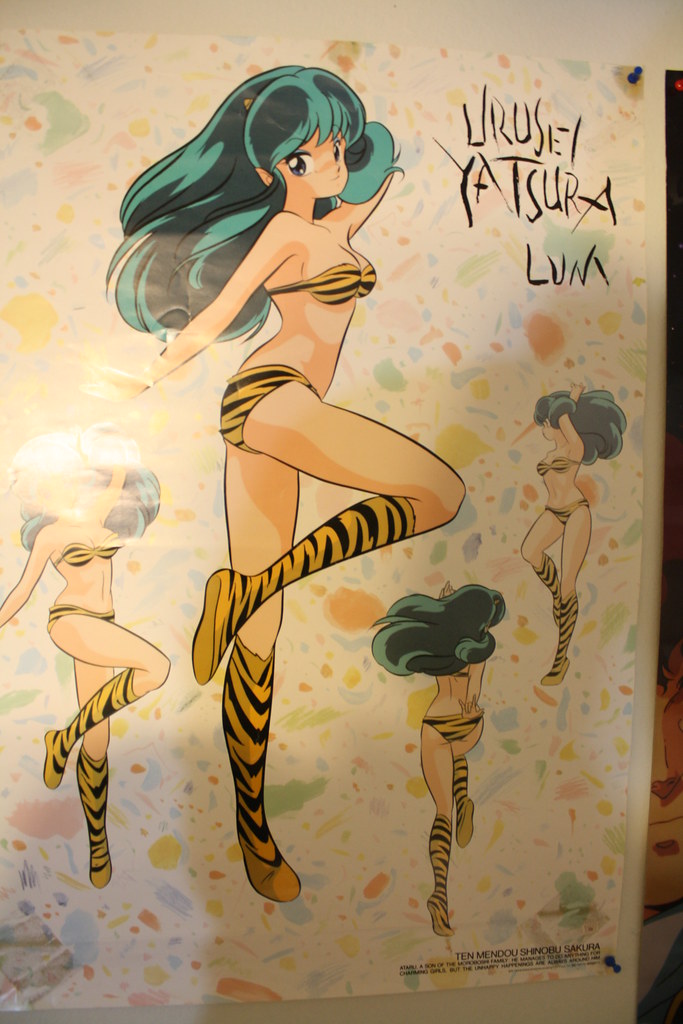

Rumiko Takahashi is arguably the most influential mangaka of all time, and she can be heavily credited with helping bring manga and anime to the western world. We've loved covering her shows like Ranma 1/2 and Inuyasha, but we finally wanted to spotlight Rumiko Takahashi herself. Her story from childhood to mangaka powerhouse isn't what you might expect. She wasn't a prodigy; she wasn't creating manga at the age of 3. But she was dedicated and passionate about what she loved, and it shows through her entire life.
Hiromu Arakawa
When Hiromu Arakawa (1973-) was in high school, she also had to work for the family dairy farm. During this period, Arakawa took oil painting classes and drew dojinshi manga for a magazine. She always wanted to be a manga artist and moved to Tokyo in 1999 to work with different publishers. Stray Dog was her first solo artwork, for which she received an award. However, Arakawa is best known for her series Fullmetal Alchemist. She also had another successful series, Silver Spoon, which was more realistic with less fantasy. Arakawa still lives in Tokyo and is married with three children.
Fullmetal Alchemist has a complex theme and significant violence and brutality. The strong and powerful characters move through death and resurrection scenes, retribution, and bloody outcomes. The story is based on the practice of alchemy and the ability to lose body parts, hoping to restore themselves to normality. Edward Elric (11.5.10) and Roy Mustang (11.5.11) are two characters. Arakawa creates passion, feelings, and emotion in the characters' faces. Each of the faces in the images portrays different looks and intensities. The theme and plot of the story are balanced despite the tragedy and aggressive action.
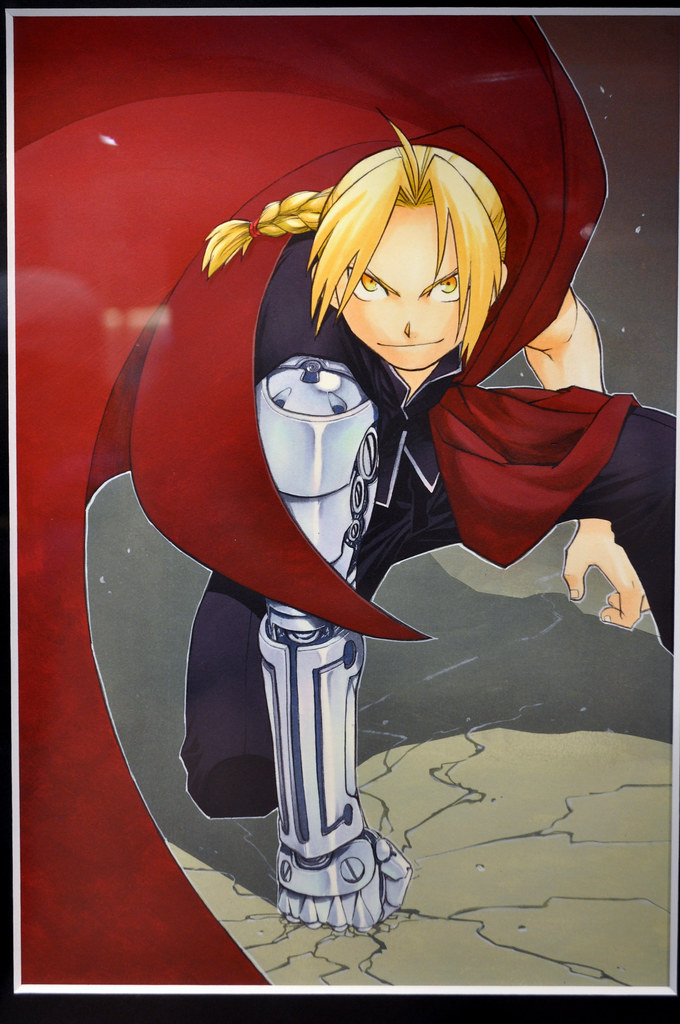
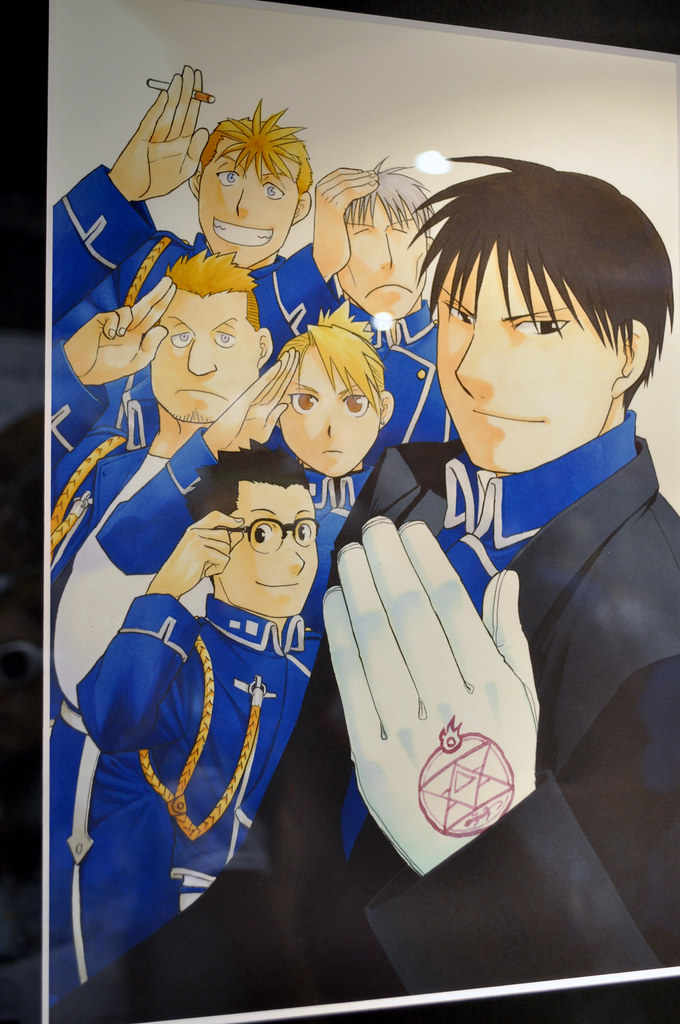
An interview in 2017 with Hiromu Arakawa, author of the Japanese famous manga Fullmetal Alchemist. Her first appearance on TV.
Eiichiro Oda
Eiichiro Oda (1975-) was from Kumamoto, Japan. As a child, he was a big fan of Akira Toriyama's series,Dragon Ball. By age seventeen, Oda won several awards for his manga works. In 1997, Oda published One Piece, which became the best-selling manga series ever. By 2019, the series sold 450 million copies worldwide, and Oda was ranked as the fourth greatest manga and anime creator.[2] Volume 56 of One Piece, produced 2.85 million copies, the most extensive print run of any Japanese manga[3] , and volume 67 surpassed the record with 4.05 million copies, again setting the record for the most copies of first printing.[4] Oda was known as a hard worker and slept only a few hours a day while working on a project. He has also received multiple awards.
One Piece (11.5.12) started with a few child-like characters who grew up within the series. Oda developed a large set of characters (11.5.13) for the series, and his story about pirates became one of the major sellers. The series was based on the escapades of Monkey D. Luffy and his Straw Hat Pirates. They explore the region looking for treasure and assume the King of the Pirates title. The series was also made into animated movies, art books, and multiple types of merchandise. One video is an example of a simpler time with younger animated characters. The second video was made with real actors, giving it a different look.


Monkey. D. Luffy refuses to let anyone or anything stand in the way of his quest to become the king of all pirates. With a course charted for the treacherous waters of the Grand Line and beyond, this is one captain who'll never give up until he's claimed the greatest treasure on Earth: the Legendary One Piece!
Free Yourselves. Take to the Seas. The Journey to find the ONE PIECE
Keiko Takemiya
Keiko Takemiya (1950-) was part of the Year 24 group. She was interested in art and writing and applied for different contests in high school. Takemiya even received an honorable mention for one entry. As part of the Year 24 group, Takemiya pioneered a new shōjo manga genre illustrating love between men. The genre became known as "boy love" or shōnen-ai and was probably the first recognized male-male kiss in shōjomanga. Takemiya was considered "one of the first successful crossover women artists" [6] , creating shōjo and shōnen manga. Kaze to Ki no Uta and Toward the Terra are Takemiya's best-known works. Both stories and some of her other works have been translated into video. Takemiya taught at Kyoto Seika University, became Dean of the Faculty of Manga, and then the university's president. One of her goals at the university was to use digital technology to preserve manga manuscripts accurately.
Toward the Terra was one of Takemiya's best-known works. As part of the future, the earth will be environmentally destroyed, and people will be left to create a living place elsewhere. A supercomputer controls the population, even how many children are born. A new advanced race emerges named the "Mu." Their dream is to find earth and return. Because the number of children allowed is created separately in vitro, the Mu try to find all their offspring before returning them to Earth. The series was top-rated, translated into multiple languages (11.5.14), and made into a movie and a TV series. In the first video, Takemiya is interviewed about Toward the Terra. The second video is a short clip from the television series.

Satoshi Tajiri
Satoshi Tajiri (1965-) was born in Setagaya, Japan. Tajiri is well-known for creating the Pokémon series. Growing up in a rural area, he was fascinated with insects, amassing an extensive collection. Initially, he wanted to become an entomologist. As Japan continued to industrialize and pave over its rural areas, Tajiri, who loved arcade games, wanted to make a game so children could catch and collect creatures. He played many video games as a teenager, missed a lot of high school, and went to a two-year technical school instead of the university. At the school, he majored in electronics and computer science.
Tajiri started a magazine called Game Freak to help gamers achieve better results. Tajiri also started working with his friend Ken Sugimori to illustrate the magazine. Tarjiri thought of the Pokémon idea and thought it would work well on gaming systems. He wanted the systems to interact similarly to bugs crawling back and forth. It took six years to create the first release of the game Pokémon (11.5.16, 11.5.17), with Sugimori illustrating the first 151 images. Several different Pokémon ideas were developed, and Tarjiri even had the characters faint when they lost a game instead of dying so children could play. The characters could be used in different games. Pokémon became a worldwide phenomenon, one of the world's most visible products for logos, clothing, toys, merchandise, and other image uses. Electronic Gaming Monthly considered Tajiri one of the world's ten most influential people in the video game market.


While Pokémon is the biggest media franchise in the world today, its creator company, Game Freak, had humble beginnings. It started not as a company, but as a self-published magazine ran by a game fanatic with poor grades and an artist kicked out of his home. What drove them forward was the same thing: passion for the arcade. Despite the long odds and society’s expectations, these two forged onwards in order to create something they loved, and that would go on to change the world.
At first, there was no real telling how successful Pokémon would become. This was especially the case during the original development of Pokémon Red and Pokémon Green which, after six years of trouble development, finally released in Japan in 1996.
Additional text/introduction.
Naoko Takeuchi
When Naoko Takeuchi (1967-) attended high school, she belonged to the astronomy and manga clubs, two experiences she later used in her work. Takeuchi studied chemistry at the university because her father thought scientific pursuits led to a better career. She graduated with a degree in chemistry and was a licensed pharmacist in Japan. However, after graduating, Takeuchi submitted some work to a publisher who printed it. Takeuchi received an award for the best new artist for her initial submission. Takeuchi married in 1999, and they have two children. She continued working on other projects but wanted to create something more aggressive based on outer space and incorporating girl fighters as superheroes. Her series Sailor Moon was an immediate success. Takeuchi continued developing multiple series while moving into anime and animated some of her work, including Sailor Moon. Eventually, Takeuchi became the production manager for future films, and some films are still based on the concepts of her successful work, Sailor Moon.
Takeuchi used names from her own family as characters in Sailor Moon. She also used her chemistry background; some characters are named based on different minerals or gemstones. Takeuchi even used her neighborhood as the primary site for the characters. The girls in the series wore clothing like sailor suits, a standard uniform for girls in Japan. The main character, Usagi, was not athletic or a great student. After encountering a cat, she starts a journey and develops mental strength and an inspired heart, a girl who supports her friends as the new Sailor Moon. Two characters are lesbians, and Takeuchi wanted to demonstrate how girls can also have a romance. The series has been widely printed and made into movies, video games, and even stage musicals. Takeuchi even wrote songs for the movies. Sailor Moon is one of the most popular and well-liked manga series. The images for Sailor Moon (11.5.17) demonstrate the detail Takeuchi used when she created the series. The characters have the typical oversized eyes, long flowing lines, and details in specific places. The first video is an interview with Takeuchi and how she works. The second video is an example of Sailor Moon.
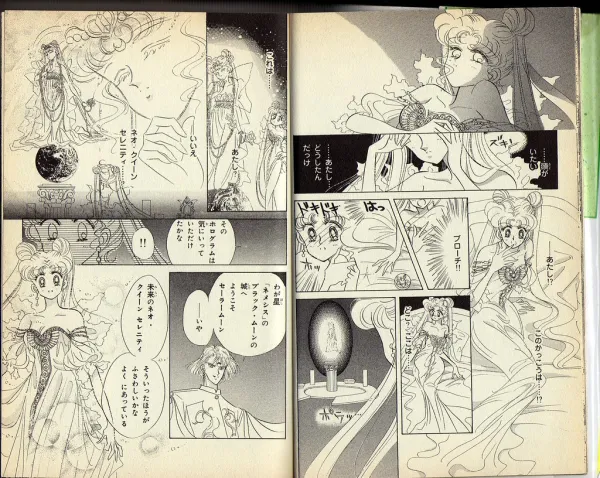
A video interview with Manga artists Naoko Takeuchi.
Hideko Mizuno
Hideko Mizuno (1939-) grew up without a missing father after World War II and a mother who died when Mizuno was young. Her family was a grandmother and an uncle. A bookstore near her house supplied her with books that grabbed her imagination. Mizuno loved manga when she was a small child, and by the age of twelve, she was entering magazine contests with her ideas. When she was entering high school, Mizuno received an honorable mention for one of her entries. A publisher saw her work and ordered some work for a magazine. Mizuno was only fifteen years old at the time. Her first work was based on a girl, and her pony was based on a "tomboy" concept for the heroine. Mizuno went to Tokyo to continue working and developing new ideas for shōjo manga. Initially, most of the manga for girls focused on a mother-daughter affiliation. Working with other women, Mizuno introduced the concept of romantic comedy. Harp of the Stars was her first manga based on romance and one of the first of this style to be made by a woman. She was also known for the first shōjo manga with a boy as the protagonist, historical drama, sexual scenes, and her unusual story based on rock music and civil rights, Fire. Mizuno was considered a pioneer, a groundbreaker, and influential for the next generation.
When Mizuno wrote Harp of the Stars or Hoshi no Tategoto, she broke the taboos of romantic stories for shōjo magazines. Mizuno stated, "In our school days, boys and girls played apart even though we attended the same school. Despite our interest in each other, I thought it was strange that we couldn't be closer. Even marriage was all about arrangements, not love. All of the world's great stories and movies show beautiful romance. So, I thought it would be good to do the same in manga."[7] In the story Harp of the Stars (11.5.18), the young girl is the daughter of a count. A group of intruders enters the room, a harpist rescues the girl, and the romance begins. The beauty of butterflies and flowers surrounds the girl. The video contains an interview with Mizuno.
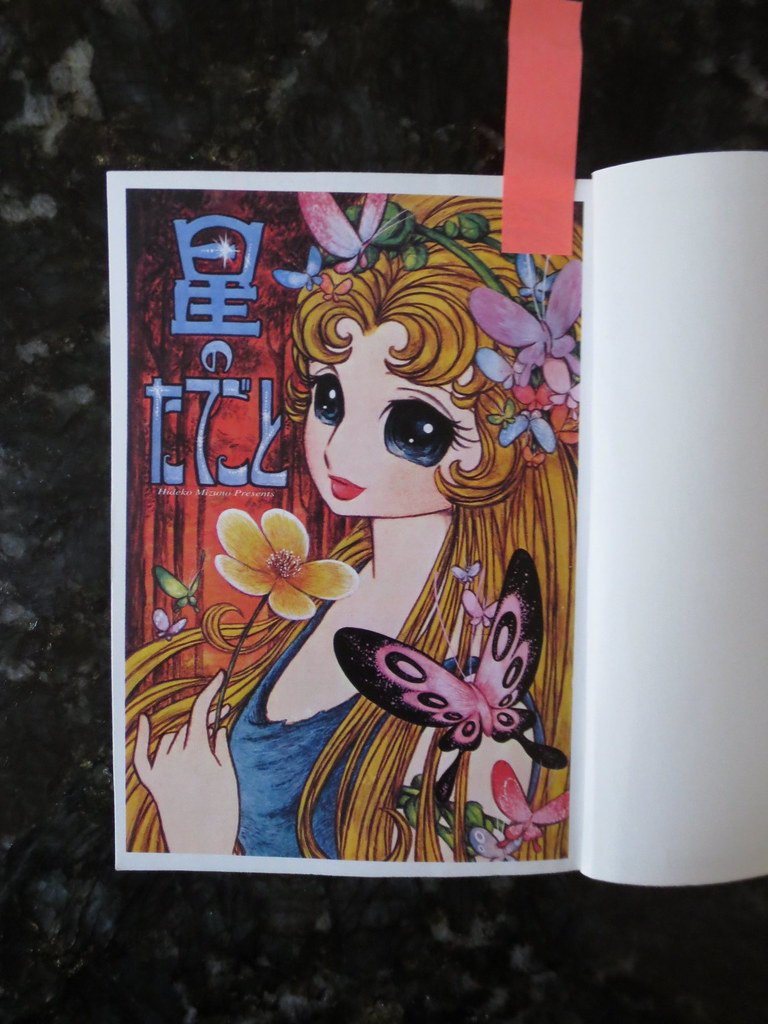
Manga master Hideko Mizuno, shôjo manga pioneer, tells us how he managed to make her debut and the role of "manga god" Osamu Tezuka in it all.
[1] Manga/Anime Topics Or, What Hasn't Been Turned Into Comics in Japan?
[2] Schodt, Frederik L. (1985). "Reading the Comics". The Wilson Quarterly. 9 (3): 64.
[3] The Magnificent, Revolutionary Year 24 Group
[4] Ibid.
[6] 365 Days of Manga, Day 2: Andromeda Stories
[7] Girl’s Manga Pioneer Mizuno Hideko: Her Message for the Modern Day


